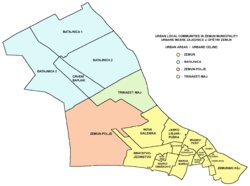Donji Grad, Zemun
| Donji Grad Доњи Град | |
|---|---|
| Urban neighbourhood | |
 Donji Grad Location within Belgrade | |
| Coordinates: 44°50′31″N 20°24′47″E / 44.84194°N 20.41306°ECoordinates: 44°50′31″N 20°24′47″E / 44.84194°N 20.41306°E | |
| Country |
|
| Region | Belgrade |
| Municipality | Zemun |
| Time zone | UTC+1 (CET) |
| • Summer (DST) | UTC+2 (CEST) |
| Area code | +381(0)11 |
| Car plates | BG |
Donji Grad (Serbian Cyrillic: Доњи Град; Lower town) is an urban neighborhood of Belgrade, the capital of Serbia. It is located in Belgrade's municipality of Zemun.
Location
| Historical population | ||
|---|---|---|
| Year | Pop. | ±% |
| 1981 | 27,569 | — |
| 1991 | 29,060 | +5.4% |
| 2002 | 28,174 | −3.0% |
| Source: [1][2][3][4] | ||
Donji Grad occupies the central part of Zemun, on the left bank of the Danube. It borders the neighborhoods of Gardoš on the north, Ćukovac and Muhar on the north-west, Kalvarija on the west, Tošin Bunar on the south-west, Retenzija on the south while the sub-neighborhood of Zemunski Kej is located along the Danube's bank. It roughly occupies the area bounded by the streets Bežanijska, Vrtlarska, 22. oktobra and Kej oslobođenja.[5][6]
Administration

The local community of Donji Grad, which comprised only the small part of the neighborhood, had a population of 8,438 in 1981. Local communities of Dunav and Zemunski Kej were detached from Donji Grad in the 1980s, so the population diminished to 3,214 in 1991 and 3,104 in 2002. However, with all the local communities which formed Donji Grad (including 22.Oktobar, Jugoslavija and Radoje Dakić), population in 2002 was 28,174. By the 2011 census, most of the local communities of the urban Zemun area were mergend into one called Zemun.
Characteristics
Being the central part of the formerly separate town of Zemun, the major cultural, historical and administrative facilities of Zemun are located in the neighborhood of Donji Grad.
The main street in Zemun, Glavna, passes through the middle of the neighborhood. Also, almost all of the squares of Zemun are either within or bordering Donji Grad: Karađorđev, Branka Radičevića, Masarikov, Senjski, JNA, Magistratski, Oslobođenja, Veliki, and Pobede.
There are four churches: two Roman Catholic and two Serbian Orthodox (Saint Archangel Gabriel and Holy Mother of God).
Zemun's open green market, a McDonald's restaurant and a commercial zone are situated along the main road.
Also located in Donji Grade are Zemun's City Hospital, Sports' Hall "Pinki", Zemun's Gymnasium, the faculty of agriculture and the Magistrate building, the seat of the Zemun's municipal assembly.
Zemun's only park, the City park, lies below the main street.
Protection
A house and the adjoining grapevine in 4 Gospodska street are protected by the law. The house is protected as the cultural monument while the vine was protected by the city on 21 September 2014 as the natural monument. The vine is planted c1910 and still bears fruits. It is of the red grape variety, specifically the Rosette, or, as it is called in Serbia, the "Frenchman".[7]
The Spirta House, built in 1855 in 9 Glavna street, was declared a cultural monument in 1965,[8] so as the large part of Donji Grad which constitutes the Spatial Cultural-Historical Unit of Great Importance of Old Core of Zemun, which was protected in 1979.[9]
The Binder house, located in 4 Dr Petra Markovića street, was built in 1911. The representative, residential one-floor house was projected by Franjo Jenč, who constructed over 100 objects in Zemun, for the industrialist Mavra Binder. It was designed in the Vienna Secession style and is the "unique architectural concept within the Old Core of Zemun". It was declared a cultural monument in April 2013 and today is the location of the military ambulance.[10]
The Herzl house is located at 17 Gundulićeva street. Present house is built after the old one was demolished in the early 20th century. The old house was a birthplace of Jakob Herzl, father of Theodor Herzl, founder of modern Zionism. The family emigrated to Budapest before Theodor was born. The new house was designed by Jozef Marks in the Vienna Secession style. The house is a rarity in Belgrade and the entire Serbia because of the unique façade which is ornamented with five plaster trees. The one-floor house is privately owned, but as it is located within the Old Core of Zemun, the Belgrade Institute for the monuments protection drafter a reconstruction plan for the façade in 2011, but as of 2018 it has not been done.[11]
References
- ↑ Osnovni skupovi stanovništva u zemlji – SFRJ, SR i SAP, opštine i mesne zajednice 31.03.1981, tabela 191. Savezni zavod za statistiku (txt file). 1983.
- ↑ Stanovništvo prema migracionim obeležjima – SFRJ, SR i SAP, opštine i mesne zajednice 31.03.1991, tabela 018. Savezni zavod za statistiku (txt file). 1983.
- ↑ Popis stanovništva po mesnim zajednicama, Saopštenje 40/2002, page 4. Zavod za informatiku i statistiku grada Beograda. 26 July 2002.
- ↑ Stanovništvo po opštinama i mesnim zajednicama, Popis 2011. Grad Beograd – Sektor statistike (xls file). 23 April 2015.
- ↑ Tamara Marinković-Radošević (2007). Beograd - plan i vodič. Belgrade: Geokarta. ISBN 86-459-0006-8.
- ↑ Beograd - plan grada. Smedrevska Palanka: M@gic M@p. 2006. ISBN 86-83501-53-1.
- ↑ Branka Vasiljević (22 September 2014), "Hrasdt i loza nova zaštićena prirodna dobra", Politika (in Serbian)
- ↑ Branka Vasiljević (22 January 2012), "Obnova Spirtine kuće – zemunski Skadar na Bojani", Politika (in Serbian)
- ↑ Službeni glasnik, No. 14/79. 1979.
- ↑ Daliborka Mučibabić (21 April 2013), "Prestonica bogatija za šest spomenika culture", Politika (in Serbian)
- ↑ Branka Vasiljević (24 July 2018). "Ulica u Zemunu dobila ime po Teodoru Herclu" [A street in Zemun named after Theodor Herzl]. Politika (in Serbian). p. 12.
External links
